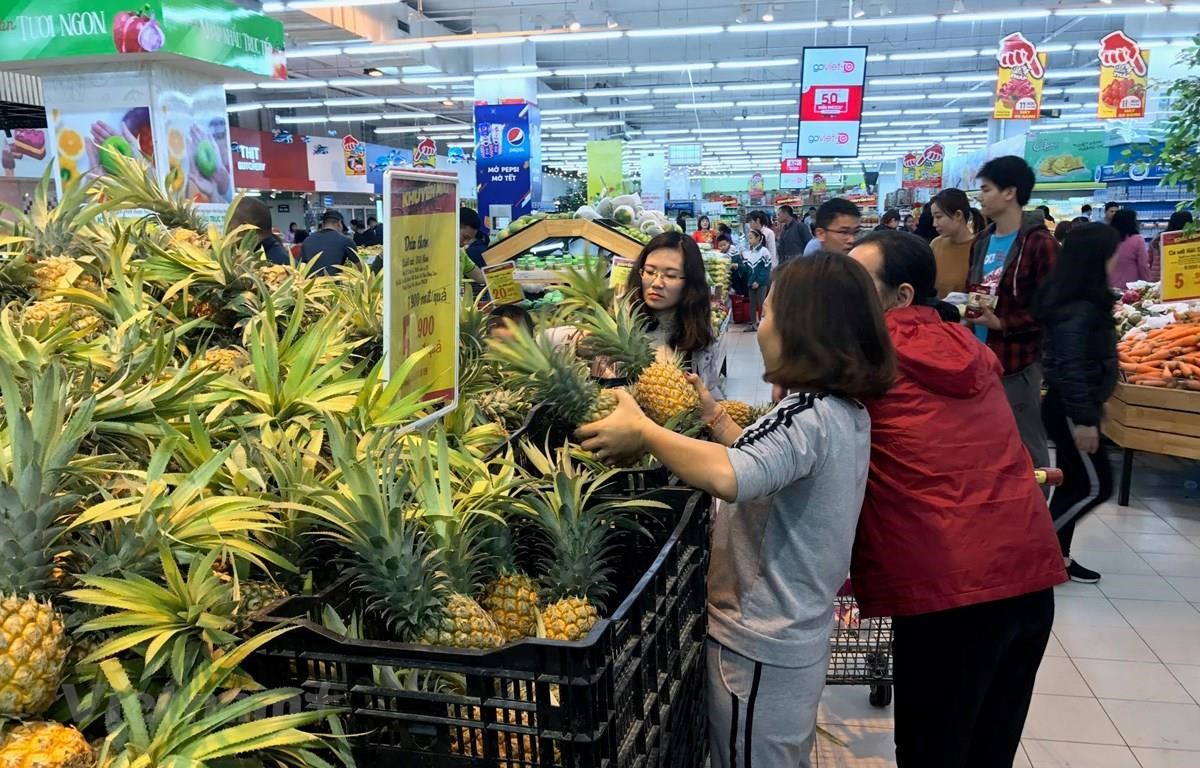Weaker shipments of key items lead to export slowdown in Q1
The trade ministry said the export of agro-forestry-fishery products faced numerous difficulties in the first months of 2019 due to oversupply and declines in some commodities' prices.

Seven of the nine items in the group of agro-forestry-fishery products experienced a decrease in export value in Q1 (Photo: VietnamPlus)
Hanoi (VNA) – The Ministry of Industry and Trade (MoIT) said the export of agro-forestry-fishery products faced numerous difficulties in the first months of 2019 due to oversupply and declines in some commodities’ prices.
The growth slowdown in the export of many key items affected overall shipments in the first quarter of this year.
Prices of agro-forestry-fishery products fall sharply
According to the MoIT, overseas shipments in March were estimated at 22.4 billion USD, up 15.4 percent year on year. In Q1, the total export revenue stood at around 58.51 billion USD, rising 4.7 percent from a year earlier.
However, the expansion in Q1 was much lower than the 24.5 percent in the same period last year. In particular, exports by domestic firms reached 17.05 billion USD, and by the foreign invested sector 41.46 billion USD (including crude oil), up 9.7 percent and 2.7 percent year on year, respectively.
Fuel and mineral exports were only about 1.03 billion USD, down 9.7 percent. Meanwhile, agro-forestry-fishery products, which accounted for 9.56 percent of the total turnover, brought home about 5.59 billion USD, dropping 10.5 percent.
Giving further explanation, the MoIT said seven of the nine items in this group experienced a decrease in export value in Q1. The export of agro-forestry-fishery items encountered a number of difficulties in the first months of 2019 due to oversupply and declines in some commodities’ prices.
For example, prices of cashew nuts fell 20.9 percent, coffee 10 percent, peppercorn 28 percent, rice 13.7 percent, and rubber 10.9 percent.
“Exports in Q1 fell sharply with very strong decreases in both export volume and prices of agricultural products, making it difficult to meet this year’s exports target,” according to Director of the MoIT’s Domestic Markets Department Tran Huy Dong.
Vietnam maintained export uptrend in Q1 thanks to processed goods. Products of the processing industry made up 83.8 percent of the country’s total export turnover, with their revenue estimated at 49 billion USD in Q1, up 6.1 percent year on year.
Some key items of this group sustained a relatively high growth rate compared to the same period of 2018 such as textile – garment up 13.3 percent to 7.3 billion USD; computers, electronic products and components up 9.3 percent to 6.93 billion USD; and footwear up 15.3 percent to 3.98 billion USD.
 Vietnam's exports to some markets in Q1 of 2019.
Vietnam's exports to some markets in Q1 of 2019.
In Q1, the US was the biggest market with 13 billion USD worth of goods imported from Vietnam, up 26 percent year on year. It was followed by the EU with 10.2 billion USD (up 2.5 percent) and China with 7.6 billion USD (down 7.4 percent).
Additionally, Vietnam shipped 6.3 billion USD worth of commodities to ASEAN markets (up 6 percent), 4.7 billion USD to Japan (up 9.4 percent), and 4.7 billion USD to the Republic of Korea (up 7.7 percent).
This year’s target could be affected
Imports during the first three months were estimated at 57.98 billion USD, increasing by 8.9 percent from the same period last year. That comprises 24.09 billion USD worth of goods imported by domestic businesses and 33.89 billion USD by foreign invested firms, up 13.4 percent and 6 percent, respectively.
The MoIT noted that up to 87.1 percent of the total imports in Q1 was materials for manufacturing and processing, reaching 50.51 billion USD – up 6.7 percent.
Some items with high import value during the period include computers, electronic products and components (11.7 billion USD, up 12.2 percent); machinery, equipment, tools and spare parts (8.72 billion USD, up 15.1 percent); fabric (2.84 billion USD, up 6.4 percent); and steel (2.83 billion USD, up 4.1 percent).
Vietnam posted a trade surplus of about 600 million USD in March and 536 million USD in Q1, much lower than the surplus of 2.7 billion USD in Q1 of 2018.
Data also show that the domestic economic sector ran a trade deficit of 7.04 billion USD, but the foreign invested one recorded a surplus of 7.57 billion USD.
 Vietnam sustained export growth in Q1 mainly thanks to processed products (Photo: VietnamPlus)
Vietnam sustained export growth in Q1 mainly thanks to processed products (Photo: VietnamPlus)
Many forecasts predict that export growth in Q2 is likely to slow down compared to the same period of 2018 as a result of a downturn in global trade, especially impact of the trade tension between the US and China, which both are leading trade partners of Vietnam.
MoIT Deputy Minister Tran Quoc Khanh said global trade recession after Q1 has been worst in 10 years.
While overseas shipments by neighbouring countries contracted, Vietnam’s export growth was not as high as expected but still positive.
In the time ahead, the Ministry of Agriculture and Rural Development should accelerate negotiations on the export of fruits to China because this country has tightened import, and if its market is not officially opened for Vietnamese farm produce, shipments to China will continue to face a number of difficulties, Khanh noted.
To step up export, the MoIT recently requested ministries, sectors and localities to coordinate to look into causes of the growth slowdown in the export of goods under their management, thus forecasting production and export growth trends for the whole 2019.
The ministry will also send delegations to localities to remove obstacles to key projects so as to foster production and export./.
The growth slowdown in the export of many key items affected overall shipments in the first quarter of this year.
Prices of agro-forestry-fishery products fall sharply
According to the MoIT, overseas shipments in March were estimated at 22.4 billion USD, up 15.4 percent year on year. In Q1, the total export revenue stood at around 58.51 billion USD, rising 4.7 percent from a year earlier.
However, the expansion in Q1 was much lower than the 24.5 percent in the same period last year. In particular, exports by domestic firms reached 17.05 billion USD, and by the foreign invested sector 41.46 billion USD (including crude oil), up 9.7 percent and 2.7 percent year on year, respectively.
Fuel and mineral exports were only about 1.03 billion USD, down 9.7 percent. Meanwhile, agro-forestry-fishery products, which accounted for 9.56 percent of the total turnover, brought home about 5.59 billion USD, dropping 10.5 percent.
Giving further explanation, the MoIT said seven of the nine items in this group experienced a decrease in export value in Q1. The export of agro-forestry-fishery items encountered a number of difficulties in the first months of 2019 due to oversupply and declines in some commodities’ prices.
For example, prices of cashew nuts fell 20.9 percent, coffee 10 percent, peppercorn 28 percent, rice 13.7 percent, and rubber 10.9 percent.
“Exports in Q1 fell sharply with very strong decreases in both export volume and prices of agricultural products, making it difficult to meet this year’s exports target,” according to Director of the MoIT’s Domestic Markets Department Tran Huy Dong.
Vietnam maintained export uptrend in Q1 thanks to processed goods. Products of the processing industry made up 83.8 percent of the country’s total export turnover, with their revenue estimated at 49 billion USD in Q1, up 6.1 percent year on year.
Some key items of this group sustained a relatively high growth rate compared to the same period of 2018 such as textile – garment up 13.3 percent to 7.3 billion USD; computers, electronic products and components up 9.3 percent to 6.93 billion USD; and footwear up 15.3 percent to 3.98 billion USD.
 Vietnam's exports to some markets in Q1 of 2019.
Vietnam's exports to some markets in Q1 of 2019.In Q1, the US was the biggest market with 13 billion USD worth of goods imported from Vietnam, up 26 percent year on year. It was followed by the EU with 10.2 billion USD (up 2.5 percent) and China with 7.6 billion USD (down 7.4 percent).
Additionally, Vietnam shipped 6.3 billion USD worth of commodities to ASEAN markets (up 6 percent), 4.7 billion USD to Japan (up 9.4 percent), and 4.7 billion USD to the Republic of Korea (up 7.7 percent).
This year’s target could be affected
Imports during the first three months were estimated at 57.98 billion USD, increasing by 8.9 percent from the same period last year. That comprises 24.09 billion USD worth of goods imported by domestic businesses and 33.89 billion USD by foreign invested firms, up 13.4 percent and 6 percent, respectively.
The MoIT noted that up to 87.1 percent of the total imports in Q1 was materials for manufacturing and processing, reaching 50.51 billion USD – up 6.7 percent.
Some items with high import value during the period include computers, electronic products and components (11.7 billion USD, up 12.2 percent); machinery, equipment, tools and spare parts (8.72 billion USD, up 15.1 percent); fabric (2.84 billion USD, up 6.4 percent); and steel (2.83 billion USD, up 4.1 percent).
Vietnam posted a trade surplus of about 600 million USD in March and 536 million USD in Q1, much lower than the surplus of 2.7 billion USD in Q1 of 2018.
Data also show that the domestic economic sector ran a trade deficit of 7.04 billion USD, but the foreign invested one recorded a surplus of 7.57 billion USD.
 Vietnam sustained export growth in Q1 mainly thanks to processed products (Photo: VietnamPlus)
Vietnam sustained export growth in Q1 mainly thanks to processed products (Photo: VietnamPlus)Many forecasts predict that export growth in Q2 is likely to slow down compared to the same period of 2018 as a result of a downturn in global trade, especially impact of the trade tension between the US and China, which both are leading trade partners of Vietnam.
MoIT Deputy Minister Tran Quoc Khanh said global trade recession after Q1 has been worst in 10 years.
While overseas shipments by neighbouring countries contracted, Vietnam’s export growth was not as high as expected but still positive.
In the time ahead, the Ministry of Agriculture and Rural Development should accelerate negotiations on the export of fruits to China because this country has tightened import, and if its market is not officially opened for Vietnamese farm produce, shipments to China will continue to face a number of difficulties, Khanh noted.
To step up export, the MoIT recently requested ministries, sectors and localities to coordinate to look into causes of the growth slowdown in the export of goods under their management, thus forecasting production and export growth trends for the whole 2019.
The ministry will also send delegations to localities to remove obstacles to key projects so as to foster production and export./.
| According to the MoIT, to achieve the target of 263 billion USD for this year, exports in the next nine months must reach about 205 billion USD, or some 22.7 billion USD each month. |













